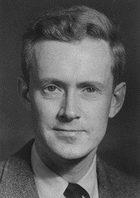Edward Mills Purcell
| Edward Purcell | |
 Edward Mills Purcell (1912-1997)
|
|
| Born | August 30, 1912 Taylorville, Illinois, USA |
|---|---|
| Died | March 7, 1997 Cambridge, Massachusetts, USA |
| Nationality | United States |
| Fields | Physics |
| Institutions | Harvard University MIT |
| Alma mater | Purdue University Harvard University |
| Doctoral advisor | John Van Vleck |
| Doctoral students | Nicolaas Bloembergen |
| Known for | Nuclear magnetic resonance (NMR) Smith-Purcell effect |
| Notable awards | Nobel Prize for Physics (1952) |
Edward Mills Purcell (August 30, 1912 – March 7, 1997) was an American physicist who shared the 1952 Nobel Prize for Physics for his independent discovery (published 1946) of nuclear magnetic resonance in liquids and in solids. Nuclear magnetic resonance (NMR) has become widely used to study the molecular structure of pure materials and the composition of mixtures.
Contents |
Biography
Born and raised in Taylorville, Illinois, Purcell received his BE in electrical engineering from Purdue University, followed by his M.A. and Ph.D. in physics from Harvard University. He was a member of Phi Kappa Sigma while at Purdue[1]. After spending the years of World War II working at the MIT Radiation Laboratory on the development of microwave radar, Purcell returned to Harvard to do research. In December 1945, he discovered nuclear magnetic resonance (NMR) with his colleagues Pound and Torrey[2]. NMR provides scientists with an elegant and precise way of determining chemical structure and properties of materials, and is widely used in physics and chemistry. It also is the basis of magnetic resonance imaging (MRI), one of the most important medical advances of the 20th century. For his discovery of NMR, Purcell shared the 1952 Nobel Prize in physics with Felix Bloch of Stanford University.
Purcell also made contributions to astronomy as the first to detect radio emissions from neutral galactic hydrogen (the famous 21 cm line due to hyperfine splitting), affording the first views of the spiral arms of the Milky Way[3]. This observation helped launch the field of radio astronomy, and measurements of the 21 cm line are still an important technique in modern astronomy. He has also made other seminal contributions to solid state physics, with studies of spin-echo relaxation, nuclear magnetic relaxation, and negative spin temperature (important in the development of the laser). With Norman F. Ramsey, he was the first to question the CP symmetry of particle physics.
Purcell was the recipient of many awards for his scientific, educational, and civic work. He served as science advisor to Presidents Dwight D. Eisenhower, John F. Kennedy, and Lyndon B. Johnson. He was president of the American Physical Society, and a member of the American Philosophical Society, the National Academy of Sciences, and the American Academy of Arts and Sciences. He was awarded the National Medal of Science in 1979. Purcell was also inducted into his Fraternity's (Phi Kappa Sigma) Hall of Fame as the first Phi Kap ever to receive a Nobel Prize.
Purcell is the author of Electricity and Magnetism (1965) — originally Volume 2 of the Berkeley Physics Course. (A 1984 second edition is meant to stand on its own.) This text is still one of the standard introductory electricity and magnetism textbooks in college physics. Purcell is also remembered by biologists for his famous lecture "Life at Low Reynolds Number"[4].
See also
- Relativistic electromagnetism
References
- ↑ http://www.greek101.com/lounge/famous.php?org=Phi%20Kappa%20Sigma
- ↑ E.M. Purcell, H.C. Torrey, and R.V. Pound. "Resonance Absorption by Nuclear Magnetic Moments in a Solid." Phys. Rev. 69 37 (1946) [1]
- ↑ H.I. Ewen and E.M. Purcell. "Observation of a Line in the Galactic Spectrum." Nature 168 356 (1951) [2]
- ↑ E.M. Purcell. "Life at Low Reynolds Number", American Journal of Physics vol 45, p. 3-11 (1977) [3]
External links
- Biography and Bibliographic Resources, from the Office of Scientific and Technical Information, United States Department of Energy
- National Academy of Sciences biography
- Edward Mills Purcell
- The story of the 21 cm line experiment, including a photo of Purcell
- Purcell's Math Genealogy
|
||||||||
|
||||||||